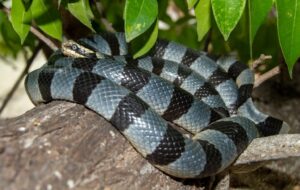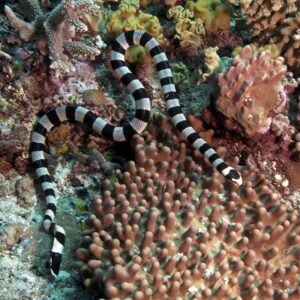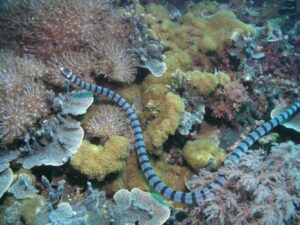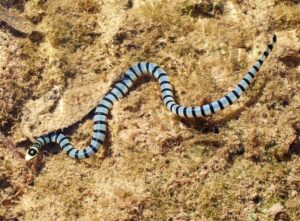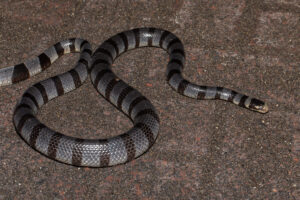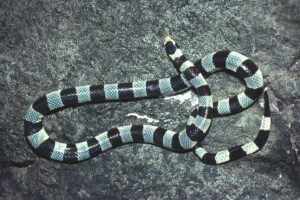The yellow-lipped sea krait, also called the banded sea krait or colubrine sea krait, is a venomous snake occurring throughout the eastern Indian Ocean and Western Pacific. It has the widest distribution of all sea snakes in its region.
This species was first described in 1799 as Hydrus colubrinus. But, after much debate and discussions, it got the name Laticauda colubrina. Their genus name ‘Laticauda’ derives from the Latin words latus meaning ‘broad’, and cauda meaning ‘tail’, which refers to the wide, flattened tail. The species epithet ‘colubrina’ comes from the Latin word colubrinus, which means ‘to have qualities of a snake’.
Scientific Classifications
- Suborder:Serpentes
- Family:Elapidae
- Genus:Laticauda
- Species:L. colubrina
Conservation Status
Description
Size
Females are typically larger than males. The average length of a male banded sea krait is about 2.9 ft (91 cm) with a 5 inches long tail, weighing 1 lb (0.6 kg). A female is 4.9 ft (152 cm) with a tail measuring nearly 6 inches and weighs 4 lbs (1.8 kg).
Color and Appearance
Banded sea kraits have slender subcylindrical bodies, with the upper part being bluish-grey and the underside a yellowish color. Their heads are black and slightly distinctive from the body. They have lateral nostrils, characteristically yellow snouts, and upper lips with the color extending up to the temporal scales through both sides of heads above the eyes. Black stripes of almost equal size cover their whole body, which narrows down towards their paddle-shaped tails. Their heads and tails may appear very similar at first glance. Due to the difference in size, males can swim faster than females.
These snakes have paddle-shaped tails that help them to swim at high speed. However, even though they can still move on dry land, due to their tails’ shape, it is nowhere near as fast as their swimming speed.
They have 21-25 overlapping dorsal scales at the midbody, and their rostral scale is undivided. There are 213-245 ventral scales, 7-8 upper labials, 5 lower labials, 1+2 temporal scales, one preocular, and two postocular. The number of subcaudals seen scales in males is 37-47 and in females 29-35.
Are they Dangerous
The yellow-lipped sea krait is one of the most highly venomous snakes in the world, with its venom having an LD50 value of 0.45 mg/kg. It contains α-neurotoxin that causes systemic symptoms like muscle weakness, respiratory failure, seizures, and severe paralysis.
Since they spend much time on land, encounters with humans often occur. Also, it is very common for them to be found in the exhaust pipes and water intake of boats. These snakes are not too aggressive and do not consider humans their prey, so they avoid humans. However, they will bite in self-defense when grabbed. Most bite incidents occur when they get tangled in fish nets, and fishermen try to untangle them. The yellow-lipped sea krait bites records are relatively fewer than other venomous species like vipers and cobras.
Yellow-Lipped Sea Krait At a Glance
Distribution
They have a widespread distribution that ranges across the coast of the Bay of Bengal that borders Bangladesh, parts of southern China, the eastern coast of India, the Malay Archipelago, Myanmar, the Ryukyu Islands of Japan, Taiwan, and parts of Southeast Asia. These snakes are also common on Fiji and other Pacific islands that fall within their range. There are also small populations in Australia, New Caledonia, and New Zealand.
On the North Island of New Zealand, six yellow-lipped sea kraits were found between 1880 and 2005. The specimens were thought to have come from their Fiji and Tonga ranges. At present, this species is New Zealand’s most common sea krait. It is also a frequently seen sea snake, second to the yellow-bellied sea snake.
Habitat
Banded sea kraits are amphibious creatures preferring coral islands, coral reefs, open oceans, mangrove regions, and shallow coastal waters. When on land, they inhabit caves, tiny crevices, and vegetation.
They spend most of their time underwater, only coming on land to digest food, reproduce, and shed old skin. These snakes show both nocturnal and diurnal behavior.
Yellow-lipped sea kraits exhibit philopatry, i.e., they tend to return to their original habitat if displaced for any reason.
Lifespan
Their lifespan in the wild remains unknown.
Predators
Natural predators of this species include bony fishes, sea birds like Brahminy kites and white-bellied sea eagles, some crabs of the genus Portunus, and sharks like tiger sharks.
Since the sides of their tails move and appear similar to the back of their heads, they confuse the predators by tricking them into thinking the tails are their heads. This buys them time to escape from threats like birds, larger fish, and sharks.
Diet
The primary diet of banded sea kraits consists of eels almost entirely. They consume eels of the Anguilliform order and Congridae, Muraenidae, and Ophichthidae families. However, a few eels living in their range might have developed a resistance towards the venom of these snakes over time.
There is also sexual dimorphism in their feeding habits. For example, females typically feed on larger conger eels due to their larger size, whereas males consume the smaller moray eels. Also, while the males forage for more than one food item, females only hunt for a singular quarry during feeding.
These snakes mostly hunt alone, but are sometimes found doing so in groups among giant trevally and goatfish hunting parties. They flush out prey from narrow holes and crevices, and the giant trevally and goatfish feed on prey, attempting to flee. This way of hunting is similar to how the moray eels hunt.
Reproduction
September to December is their breeding season, when they gather on land and around gently sloping areas in the water. During this time, males are more active on land, and their relatively small size helps them crawl faster than females. The females are polyandrous, which means they mate with several partners in a single breeding season. After recognizing a female, the male chases it to begin the courtship. They then intertwine their bodies with females, contracting rhythmically and remaining like that for several days, almost without moving.
Females are oviparous and lay about ten eggs per clutch; the eggs are laid in crevices. Information about hatchlings is still being determined since nests are rarely found in the wild. They reach their sexual maturity at 1.5-2.5 years old.
Similar Species
Belcher’s Sea Snake
The Belcher’s sea snake and the yellow-lipped sea krait have very similar appearances. However, the Belcher’s sea snake has a yellow-colored body from snout to tail. In comparison, only the snout and the belly of a yellow-lipped sea krait have a yellowish hue.
Banded File Snake
The banded or the little file snake is a non-venomous species found in aquatic habitats of northern Australia and surrounding islands, Indonesia, and along the coastal parts of southeast Asia.
Care Sheet
Size of the Enclosure: Since they are lengthy, a terrarium with at least a 20-gallon capacity that can provide a land and water area would be enough. 70% of the total space must be the water area, as the dry part will only serve as a basking area.
Substrate: For the water part, a fine or rocky sand substrate would be suitable; also, equip it with plants, rocks, and corals and make sure it’s brine. And for the land part, use plain fine sand with branches, logs, and rocks, which will aid them in laying their bodies to bask.
Temperature: Water temperature needs to be about 80⁰ F, and the land area should be 80⁰-90⁰ F.
Lighting: Equip the land area with an LED light or incandescent light; it will work as an effective tool for their digestion.
Feeding: They need to be fed an appropriate amount thrice weekly. Avoid overfeeding and do not attempt to give them rodents as they are piscivorus, and it is not a proper diet for them.
Source
reptiles.org.nz, livingoceansfoundation.org, ferrebeekeeper.files.wordpress.com, moralcoral.files.wordpress.com, inaturalist.org, ryanphotographic.com

